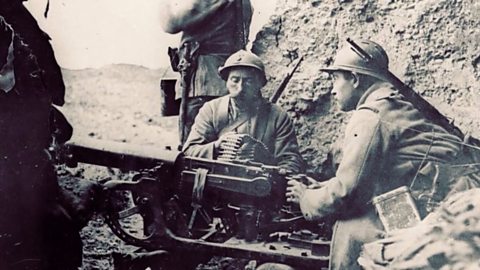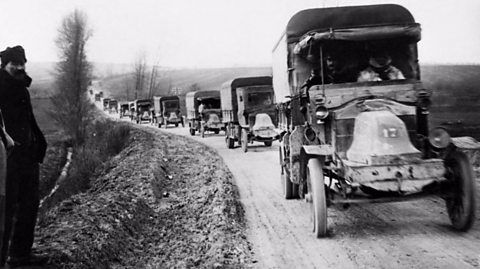War beyond the Western Front
The first battle between Germany and Britain in World War One took place not on the muddy fields of France but in the scrub land of Togo.
Keen to compete with its European rivals, Germany acquired overseas colonies like Togo in the late 1800s. As Kaiser Wilhelm II declared, Germany wanted its 'place in the Sun'.
When war broke out these colonial outposts would make important bases for Germany's navy and global communication network. But this would also make them high-value targets.
A bit of Germany in a foreign land
In the 1880s Germany established a number of colonies in Africa and the Pacific.
Click or tap on the map below to explore them.
Cutting Germany's lines of communication
Togoland was home to Kamina wireless station. But why was it so important to Germany and why were the British and French so keen to destroy it?
Kamina wireless station was completed in July 1914 and was a pivotal point for German naval communications in the Atlantic. Its nine masts meant it was high-powered enough to link all of Germany’s African colonies with Berlin. This enabled it to send reports of Allied naval movements around the coast of Africa. The British feared this would put troop ships from Australia, New Zealand and South Africa in danger of attack.
Merchant ships were also at risk. Britain relied heavily on its empire for resources, from steel to wool to horses. A British liner carrying 30,000 chests of tea was captured by a German cruiser off the east coast of Africa, just two days in to the war.
So it was imperative to Britain that Germany’s long-range communications were knocked out. In the first days of war the cabinet made the decision that all wireless stations in German colonies should be destroyed. Top of the list… was Kamina.
The race to Kamina Wireless Station
All Britain’s foreign dominions were notified of the outbreak of war at the same time. Lacking instructions from London, each territory responded as they thought fit.
In neighbouring Gold Coast (Ghana) the Regiment Commandant was on holiday in England, leaving an ambitious young officer called Captain FC Bryant in charge. On his own initiative he demanded that the acting commander of Togoland surrender the colony.
On the 6 August the British intercepted a message revealing German forces were withdrawing from the capital Lomé to protect the Kamina wireless station 100 miles inland.
A quick advance
The German force was small with only 300 German and 1,200 native troops. They didn’t have the support of the local population who informed the Allies of their movements.
The British took Lomé easily on 7 August. More British forces invaded Togoland from the west while the French arrived from the east. Together they took control of the south. They began to advance towards Kamina and on 12 August Alhaji Grunshi became the first soldier in British service to fire a shot in the war.
The fall of Kamina
German forces tried to slow the Allies' movement north, destroying railway bridges and launching ambushes. They inflicted major casualties and on 22 August Lieutenant George Thompson became the first British officer killed in action in World War One.
Outnumbered, the Germans retreated and a few days later burnt Kamina to the ground rather than let it fall into the hands of their enemy. On 26 August Captain Bryant accepted the German surrender and Togoland was carved up between Britain and France.
Learn more about this topic:
WW1: How did an artist help Britain fight the war at sea? document
Dr Sam Willis discovers how the British artist Norman Wilkinson developed dazzle camouflage to protect ships from German U-boats in WW1

WW1: Why was the first day of the Somme such a disaster? document
The first day on the Somme, 1 July 1916, was the bloodiest day of World War One for the British army. Where did it all go wrong?

WW1: What caused Verdun to be the longest battle of the war? document
Verdun was the longest battle of World War One, lasting a total of 300 days. Logistics, politics, pride and strategy all helped to prolong the conflict.
